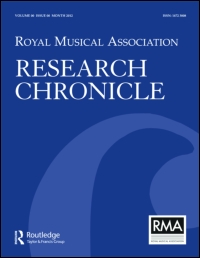Article contents
A Textual-Musical Inventory and Concordance of Munich University MS 328–331
Published online by Cambridge University Press: 01 January 2020
Extract
Munich University MS. 328–331 is an important early 16th-century musical repertory. Its contents of 145 pieces are largely of German origin and most settings are of the genre referred to as Tenorlied. Whereas the majority of pieces in this repertory exist in at least one other source, many settings are unique and have no known concordances. Most of the composers represented by this collection were closely associated with the court of the Holy Roman Emperor Maximilian I, whose large musical establishment at Innsbruck at the beginning of the sixteenth century included Isaac, Hofhaimer, Senfl, Adam Rener and Heinrich Finck. The number of vocal and instrumental performers in Maximilian's “Capelle” is not only substantiated by several surviving contemporary inventories and payment records, but such pictorial evidence as the famous and frequently reproduced series of woodcuts, The Triumph of Maximilian I. The several musical illustrations among the 136 reproductions by Hans Burgkmair, Albrecht Altdorfer, Hans Springinklee, Hans Scháuffelein, Leonhard Beck and Albrecht Dúrer, corroborate the court records and give some idea of the way in which instruments and singers were combined in different kinds of musical performance. The musical repertory of Munich University 328–331 (hereafter abbreviated and simply referred to as Mub), is just the sort of music described in the various “Schrifttafel” that were intended to be printed with the woodcut illustrations.
- Type
- Research Article
- Information
- Copyright
- Copyright © Royal Musical Association, 1970
References
1 Wien, Österreichische Nationalbibliothek, Codex Min. 77, f. 10.Google Scholar
2 Wien, Staatliche Graphische Sammlung Albertina, “Kopie des Miniaturentriumphzuges”, no. 10.Google Scholar
3 Robert Eitner, “Ein deutsches Liederbuch im Manuscript.” M. f. Mg., 1900, no. 6, p. 97 ff.Google Scholar
4 Heinrich Isaac Weltliche Werke, ed. by Johannes Wolf, DTö vol. 28 (Jg.XIV1), Vienna 1907 (repr. Graz 1959).Google Scholar
5 For further details on watermarks, ownership, dating, etc. see Gottwald, Clytus, Die Handschriften der Universitätsbibliothek München. Wiesbaden 1968, p. xi ff. and p. 83.Google Scholar
6 M.f.Mg., 1900, pp. 97–98.Google Scholar
7 Bruno Hirzel, “Dienstinstruktion und Personal status der Hofkapelle Ferdinand's I. aus dem Jahre 1527.” SIMG, vol. X, 1909, p.153.Google Scholar
8 The four-part division of the choir was as follows: 21 “Singer-knaben” (boy sopranos), 7 “Altisten”, 6 “Tenoristen” and 6 “Bassisten”. See Hirzel, op. cit.Google Scholar
9 That Senfl and Wagenrieder were closely associated for some time, both at Innsbruck and Munich, explains the latter's use of the word “Geselle” (comrade or close friend) when referring to Senfl in a letter dated “Münichen den 9 Februari im [15]36 iar”.Google Scholar
10 Robert Eitner, “5 Briefe von Lucas Wagenrieder von 1536–1538.” M.f.Mg., 1876, no.3, p.26.Google Scholar
11 Letter dated “München den 4. Augusti im [15] 37 iar”. M.f.Mg. op. cit. p. 28.Google Scholar
13 Wien 18810, folios 37–38.Google Scholar
14 Hans Joachim Moser, Paul Hofhaimer. Stuttgart and Berlin, 1929, p. 29.Google Scholar
15 Gottwald, op. cit.Google Scholar
- 1
- Cited by




